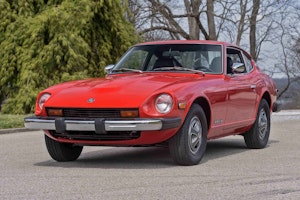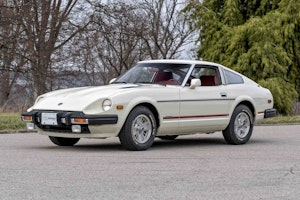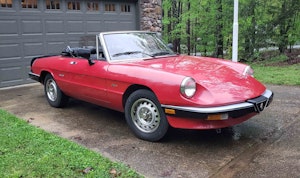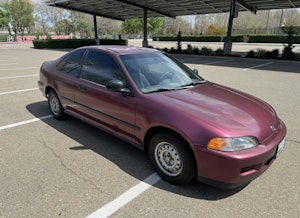Media | Articles
Homegrown: The Warbird Jeep
I consider myself fortunate to have grown up on a dairy farm, surrounded by ample tools, a vast pile of scrap steel, and old tractor parts ripe for exploration. It was there that I honed my fabricating skills from a young age. By the time I turned 24, I had successfully constructed my first hot rod from scratch.
Shortly after I achieved that milestone, however, I encountered unexpected medical complications that rendered me unable to work or even walk for two years. Confined to my chair, I spent what felt like an eternity immersed in dreams of crafting another hot rod.
[Welcome to Homegrown—a limited series about homebuilt cars and the ingenuity of their visionary creators. Do you know a car and builder that might fit the bill? Send us an email to tips@hagerty.com with the subject line HOMEGROWN. Read about more Homegrown creations here. —Ed.]
Shortly after my recovery, I embraced a role as a line service technician towing and fueling aircraft at a nearby airport. Right next door to us was a vintage aircraft restoration shop called Aerometal International, and often I would watch from our ramp as they pulled their DC3s and other vintage birds out of the hangar—millions of button-head rivets protruding from polished aluminum panels, all of it twinkling in the sunshine. I loved to hear the radials fire up, and I savored the scent of burnt avgas.


I had always been an enthusiast of World War II aircraft and military vehicles, but now I had a front-row seat, and such close exposure to those lovely old machines ignited a real passion. Over time I watched as they meticulously disassembled various planes down to the frames, then reconstructed them almost like new. Although I aspired to work with those technicians, I doubted whether my skills were up to par.
Marketplace
Buy and sell classics with confidence
One day, the owner of Aerometal noticed the hot rod I had built and we got to talking. When he offered me a job, I seized the opportunity. I began my journey there by towing aircraft and handling facility chores, then later tried my hand at sheet metal. I swiftly adapted to the craft and soon developed a vision of my next hot rod build.

I wanted to create a piece of art—something that could serve as a tribute to WWII aviation as well as the iconic Jeep. No simple task. I had a design in my head of exactly what I wanted to create and wouldn’t allow myself to cut any corners. If it required thousands of hand-shot rivets in polished aluminum panels, so be it. It didn’t matter how difficult it would be; I allowed myself zero flexibility. So began my journey building the Warbird Jeep under my new side business, Bomb’n Beauties.
I completely hand-built this machine, from the frame to the steering yokes. Although I saw it as a piece of art, the Warbird Jeep is a fully functional vehicle. I wanted more than looks; I wanted this piece to strike all of the senses.



I started by putting an old unusable Jeep body on a rotisserie. I wasn’t going to use the body, but I knew I’d be able to spin it around and pull all the measurements and angles off the Jeep and put them to paper. Knowing full well it would be difficult squeezing in a V-8, I wanted my build to match the original dimensions as best I could. I also used it as an opportunity to run tape lines everywhere I thought I might like to see stringers and rivet lines.
After deciding how the body would be built, I had a better understanding of how it would interact with my frame. I built the frame out of thick-wall rectangular tubing. I knew an aluminum-bodied car would be extremely light, so I needed to add some weight. This also made my frame more than capable of handling the V-8 I had in mind.
I slightly modified a 1960 Ford F-100 front axle to fit my front end, with radius bars and a transverse leaf setup. I wanted a front axle that could handle the larger Jeep tires at high speeds. I used a 12-bolt Chevy axle in the rear, with a four-link suspension and coilovers.




Choosing the 350-cid crate V-8 with an automatic transmission was a decision I’d put a lot of thought into. I had considered using some kind of aircraft powerplant but ultimately decided against it. Aircraft engines require a lot of care and maintenance. They also require a mechanic with aviation expertise. Instead, I decided on something that would always operate and require less regular attention.
Building the body was the most difficult and time-consuming part, as I wanted it to be just like that of an aircraft. That meant riveting it all together rather than welding. I utilized stringers, just like in aircraft, for structure.

Anyone who has ever attempted to shoot rivets will understand the agony I endured. Every rivet location was hand-drawn, drilled, deburred, and shot. I used standard aviation AD rivets, and they’re incredibly difficult to shoot without having an unrecoverable accident. Each time I did have an accident on a panel, I started over. I didn’t want any imperfections on this piece. By the end, I had installed more than 4500 rivets into the body. The only panel that utilized a CAD-drawn image and laser-cut was the instrument panel. Everything else was built by hand.
With everything on the exterior following an aviation appearance, I wanted the interior to feel like a cockpit. The passenger side mirrors the driver’s side, with full gauges and a functional yoke. All of the center gauges are functional vintage aviation instruments running on vacuum. Even the mag switch works as vehicle battery power. The shifter is crafted to look and feel like a throttle quadrant. A breaker panel replaces conventional fuses, while white-wire looms, neatly tied every few inches, starkly contrast the Pratt & Whitney color-matched paint adorning the drivetrain. I also hand-built the bomber seats with cushions that appear as if the operator left his parachute behind when he got out of the vehicle.



There are too many hidden features on this Jeep to list. I wanted it to keep surprising the viewer the more they looked. Subtle details are everywhere: navigation lights; recognition lights; .50-caliber gun barrels that function as turn signals; fuel tanks that are hand-made bombs hiding under a lightning hole-filled panel in the rear; stainless steel plumbing; standard aviation AN fittings . . . It’s difficult to capture all the details through photos.

I could not have completed this project without the support of my incredible wife. I personally had more than 3500 man hours in this creation over a span of three and a half years, all while maintaining a full-time job. My wife handled the house and kids, which, in my opinion, was probably more difficult than building the Warbird Jeep. I was also quite fortunate to be surrounded by a handful of incredibly skilled friends at work. I was able to tap into each friend’s personalized skill sets for help with paint, polish, wiring, sewing, and so on, so I could stay focused on design and fabrication. Their contribution was around five hundred hours, for which I am eternally grateful.
It’s an amazing feeling to see a dream come to reality. I look forward to creating more automotive masterpieces that captivate the imaginations of car and aviation enthusiasts.
***
Check out the Hagerty Media homepage so you don’t miss a single story, or better yet, bookmark it. To get our best stories delivered right to your inbox, subscribe to our newsletters.
































Nice Jeep. A local did a similar stance with taller wheels and air suspension. He sits it right on the ground.
Very nice. What incredible attention to detail.
Congrats on the build and a well written article.
Incredible craftsmanship
Otherworldly craftsmanship and attention to detail… but, unfortunately, the run-of-the-mill crate Chev and automatic scream modern convenience, abruptly breaks the continuity, and shot the balance of the theme down in flames… for me.
Too bad the original aircraft powerplant idea including some sort of contrived vintage manual shifting aparatus was jettisoned.
Lots of detail on this build. Pretty cool!
A lovely tribute vehicle to those warbirds and vintage aircraft you and others love. Amazing skill and dedication!
My relatives fly single engine planes, so I’m familiar with the aviation theme. Excellent build and craftsmanship!! You perfectly represent the military and aircraft. I agree with the engine choice – an aircraft power plant would have made it difficult to enjoy. Drive it!! And yes, our wives and friends also deserve recognition. And if you completed this build in only 3500 hours, you da man!! Great build!
All this and only two wheel drive??
This is a brilliantly-conceived combination of automotive and aviation history! Well done! I especially liked the dual-control cockpit and all of the subtle aviation-inspired touches (e.g., the tear-drop side marker lights, the safety wire on the control wheel nuts, etc.).
I agree that it would’ve been nice to include an aircraft engine as the powerplant, but as an engineer myself I appreciate that every design is a compromise, and concur that an aircraft engine would have just been impractical in the long-run. Pity, though: a V-12 Merlin would have really made this hot rod fly! In the end, the only thing I think you missed was some nose art!
Incredible job. I would take that Jeep over a Ferrari any day of the week. Also, you’re fortunate to have a good woman, kudos’ to her.
Outstanding! are you making it available for sale in a kit? I have an engine which I have been looking to drop in something sweet like your creation.